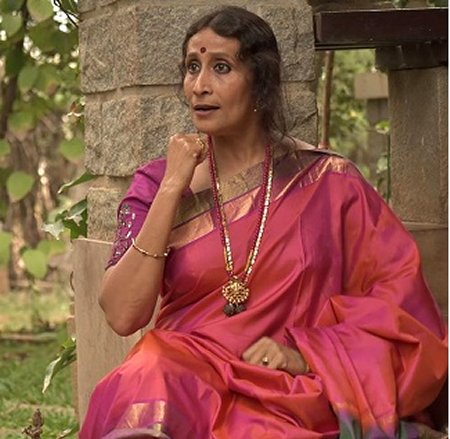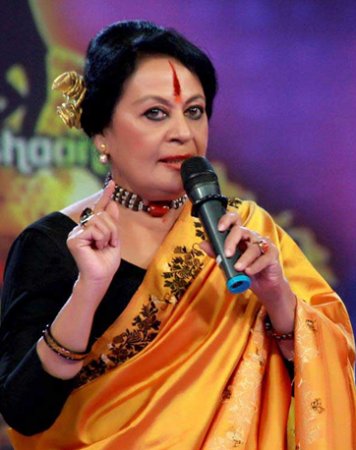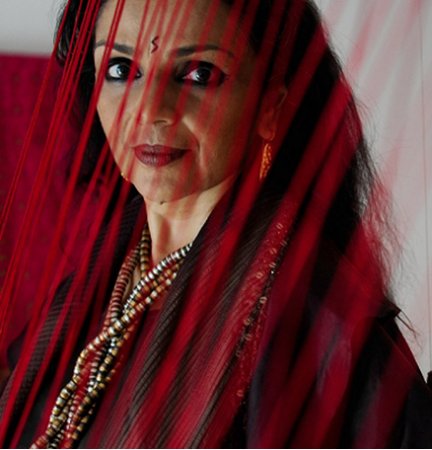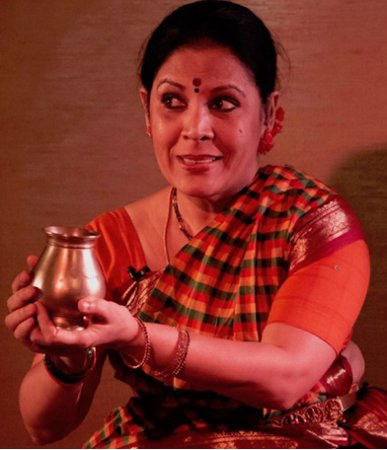
|   |

|   |
 e-mail: leelakaverivenkat@gmail.com Inspiring week showing indomitable spirit of dancers May 24, 2020 Dancers would seem to have been busier than ever on the internet. For over two weeks Kuchipudi dancer settled in Bangalore, Vyjayanthi Kashi's Herculean effort of an Online International Seminar on Kuchipudi hosted under the aegis of her institution Shambhavi School of Dance, attempting to feature in one sweeping canvas, artistes representing both traditional and contemporary versions of an art form, which passing through the corridor of time, from its Yakshagana avatar to the solo Kuchipudi of today, has met with more changes than many others. I enjoyed watching and listening to the cogency of Pasumarthy Ramalinga Sastry with his additional Kalakshetra experience, as he dilated on the differences between the Kuchipudi Yakshagana and the dance drama that Rukmini Devi pioneered. I noted his strong response when the usual explanation of music having taken the place of 'Vachika abhinaya' of Yakshagana was offered in the discussions, that trying to make what was a 'convenience', a substitute was no answer. With the support systems for Yakshagana troupes no longer available, and with the solo form emerging with dancers from different areas taking to Kuchipudi, the first casualty was bound to be the language, the main repository of the identity of cultural traditions.  Vyjayanthi Kashi The integrated approach in Yakshagana which called for performers trained in all disciplines like music, dance, theatre and literature, gradually became separate specialised groups representing each of the disciplines - coming together as aspects in a performance, with the main stage artistes becoming solely dramatic dancers. In the seminar, those hailing from the old Parampara, understandably spoke in Telugu. And here, notwithstanding the earnest attempts of the organisers, what was sorely needed and would have further enriched the proceedings for all across the globe, was an expert in both Telugu literature and English - enabling a faithful synopsis not missing out on the intricacies of what was said in Telugu. Which is not to take away from the laudable attempt of such an ambitious venture! Representing in true sense a renewal and rebirth, was the Punarnava series under Natyarambha (conceived by dancer Ananda Shankar Jayant) which centre-staged in every sense of the term a triumph of the human spirit refusing to be cowed down by adversity. Curated with imagination, what was called the 'Manodharma' towards the end, comprising mudra, mood, metaphor saw some interesting answers from a fine selection of very articulate dancers. Hilarious was Anita Ratnam's idea of a conversation with Andal with tennis stalwart Nadal sitting at her feet listening to the whole thing! Like a resurrection, emerging literally from the depths of a life crippling car accident, to resume a suddenly halted career as a star dancer, and going on to create history, the life story of Dr. Sonal Mansingh, now a Rajya Sabha member, is worth being told often - particularly during times like this with dancers during the Covid-19 pandemic feeling rudderless, with the ground from under their feet disappearing as it were. In her usual fluent style, reimaging the trauma of those days in a program appropriately called "Resurrection through Dance", Sonal Mansingh interviewed by Ananda Shankar Jayant stressed on two important qualities - courage and conviction - most needed to lead life on one's own terms, not allowing oneself to be steam-rolled by societal attitudes. What seemed to keep her mental strength steadfast, willing her as it were to come back to normalcy, was that feisty dance urge.  Sonal Mansingh  Ananda Shankar Jayant Not surprisingly, in all my years of dance writing, I have experienced repeatedly, the therapeutic power of dance in nursing the most bruised bodies and hearts, back to normal health. Ananda, in "C for Choice" shared her own story of refusing to succumb to an impediment like Cancer and her choices of pursuing training in Kalakshetra while acquiring all the educational degrees studying privately - and following a professional career which accommodated a responsible bureaucratic post serving the Indian Railways, alongside a career as a fully committed dancer running her own institution. Choosing to be outside the Chennai Sabha culture, she has still made a name in dance notwithstanding the 'oh, she is not a fulltime dancer' comments. Anita Ratnam's exchange with Ananda in "Barefoot and Solo" was the epitome of panache and silver-tongued fluency, recounting the complete change in her life after the collapse of her marriage, after years of a partnership with both husband and wife successfully establishing and running a Television company in New York. Ironically it was her overweening success as a television personality, which proved too much for her husband to accept and live with. Leaving for India, with two very small children, determined, not to try and recapture the Bharatanatyam Margam dancing days, she courageously carved out a new career for herself. She started Narthaki, published an excellent directory of Indian classical dancers, started collaborating and working with groups of young dancers and produced work showing new directions - and the rest is history. The best part of what she wanted young artists to do was not to think they were 'divas' (because hardly anybody is), and to learn to laugh at life and to look after their instrument - the body. She advocated that youngsters get involved and cross trained in a host of disciplines like Tai-Chi, Yoga, Kalari, Theatre and other non-dance activities. And lastly, to learn to do hard work without the imitative 'cut and paste' type of work.  Anita Ratnam  Ramaa Bharadvaj The same power drove her it would seem, to become a force to reckon with overnight almost, when she managed the superhuman task of getting together a mammoth protest by artists of all denominations in California, making the Arts Council rescind its earlier decision to stops grants to the artist community due to acute paucity of funds. Now being nourished by Naada Bindu Gurukul's environment (She curates all the festivals for the Gurukul) that unseen force would seem to have enabled her reinvention as a powerful folk story teller (her latest incarnation)! Not one to advice, she however believes that youngsters avoid all pomposity and labels of being 'dancers ushering in new directions in their work' - for originality for her is a myth - and all one can do is to link ideas one has into a new avatar. Quest - A lockdown diary of a dancer  Sangita Chatterjee And the icing on the cake of programs for the week was a short delightful dance film 'Quest - A lockdown diary of a dancer' by Kathak dancer Sangita Chatterjee. The film opens with the image of desperately fluttering fingers of crossed open hands thumbs locked, jutting out from between spaces on the grilled surface of a window, resembling a caged bird - the failure to escape further conveyed in the fists intermittently clenching the grilled surface. Will the caged bird of dance ever fly again? Dance here becomes a metaphor of images like just the dancer's feet taking a circle in the measured square suggesting the social distancing the Corona restrictions demand. Sounds of flowing water, suggest a world outside. Imprisoned in a small space which in time seems to become the new norm, the dancer spins and uses her hands even as there is fear inside and outside. In a moving image showing the inevitability of the dance inside happening in all spaces is the dancing in the backyard among lines of clothes hung to dry! An acceptance and the fruitlessness of struggling against what will not change for the present, lead to a quiet reflection. What does this dance mean to her? Why does she dance? In the quietude, as her insides unconsciously respond to the dulcet tones of Thumri singing from somewhere, and her body seems to reach out as the dance happens "Ta thai thai tat tat thi....." reaching out, drawing back and from a new flux of emotions flows a new normal. As her body responds, she realises that dance is her Being. It is her inside speaking and to "impress, express or suppress" are not the primary objectives. While the concept of filming on a phone camera by Malavika speak of her poetic sensitivity, one is struck by the editing work, the minimalistic aesthetic approach and the wonderful way Nature and dancer are brought together, in the editing by the young highly promising film maker Lubdhak Chatterjee, who in earlier documentaries has shown his class. More such work by youngsters is the way to wed film and dance with new ideas!  Writing on the dance scene for the last forty years, Leela Venkataraman's incisive comments on performances of all dance forms, participation in dance discussions both in India and abroad, and as a regular contributor to Hindu Friday Review, journals like Sruti and Nartanam, makes her voice respected for its balanced critiquing. She is the author of several books like Indian Classical dance: Tradition in Transition, Classical Dance in India and Indian Classical dance: The Renaissance and Beyond. Post your comments Please provide your name and email id when you use the Anonymous profile in the blog to post a comment. All appropriate comments posted with name and email id in the blog will also be featured in the site. |